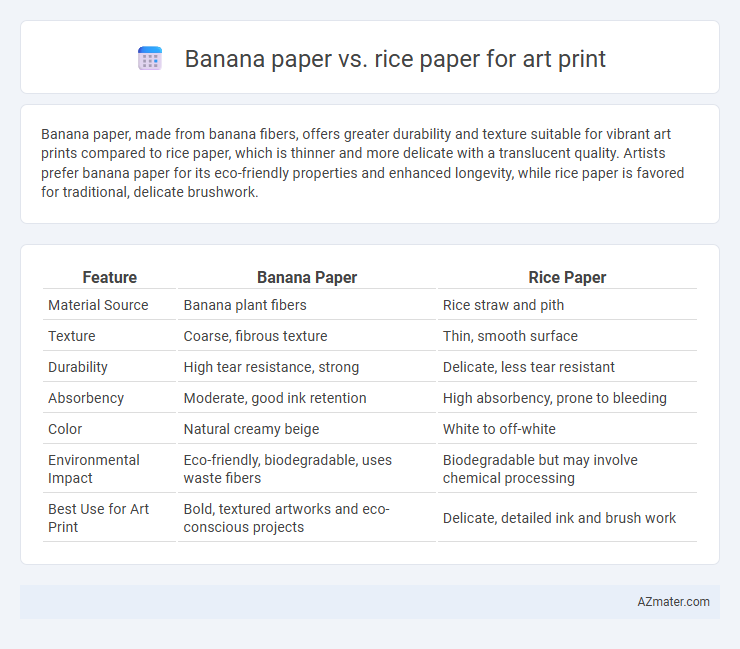Banana paper, made from banana fibers, offers greater durability and texture suitable for vibrant art prints compared to rice paper, which is thinner and more delicate with a translucent quality. Artists prefer banana paper for its eco-friendly properties and enhanced longevity, while rice paper is favored for traditional, delicate brushwork.
Table of Comparison
| Feature | Banana Paper | Rice Paper |
|---|---|---|
| Material Source | Banana plant fibers | Rice straw and pith |
| Texture | Coarse, fibrous texture | Thin, smooth surface |
| Durability | High tear resistance, strong | Delicate, less tear resistant |
| Absorbency | Moderate, good ink retention | High absorbency, prone to bleeding |
| Color | Natural creamy beige | White to off-white |
| Environmental Impact | Eco-friendly, biodegradable, uses waste fibers | Biodegradable but may involve chemical processing |
| Best Use for Art Print | Bold, textured artworks and eco-conscious projects | Delicate, detailed ink and brush work |
Introduction to Eco-Friendly Art Papers
Banana paper and rice paper are both popular eco-friendly options for art prints, known for their sustainable sourcing and unique textures. Banana paper is crafted from banana plant fibers, offering durability and a natural, fibrous surface ideal for detailed ink and watercolor work. Rice paper, derived from the pith of the rice plant, provides a delicate, translucent quality that enhances traditional calligraphy and brush painting while minimizing environmental impact.
What is Banana Paper?
Banana paper is a sustainable, eco-friendly material made from the fibers of banana plants, known for its durability and unique texture that enhances art prints with a natural, organic feel. It offers superior strength and a slightly rough surface, providing excellent ink absorption and vibrant color reproduction compared to rice paper. Artists prefer banana paper for its environmental benefits and its ability to produce high-quality, long-lasting art prints with a distinct tactile quality.
What is Rice Paper?
Rice paper, traditionally made from the pith of the rice plant or other fibrous plants, is a lightweight, delicate material prized for its smooth surface and translucent quality in art prints. It excels in capturing fine details and vibrant ink colors, making it ideal for high-resolution art reproductions and watercolor prints. Compared to banana paper, rice paper offers a more subtle texture and a softer finish, enhancing the visual depth and authenticity of traditional Asian-style artworks.
Sustainability and Environmental Impact
Banana paper is made from agricultural waste fibers, primarily banana stalks, offering a biodegradable and renewable alternative that reduces deforestation and minimizes carbon footprint in art print production. Rice paper, derived from rice straw or pith, also supports sustainability by utilizing crop residues that would otherwise be discarded, promoting waste reduction and resource efficiency. Both materials present eco-friendly options, but banana paper typically exhibits higher durability and less chemical processing, enhancing its environmental benefits for sustainable art printing.
Texture and Surface Quality
Banana paper offers a fibrous, tactile texture that enhances the depth and richness of art prints, providing a natural, eco-friendly surface with subtle variations and organic imperfections. Rice paper, known for its smooth, delicate, and translucent surface, allows for fine detail reproduction and a lightweight feel, ideal for intricate ink or watercolor prints. Artists choose banana paper for earthy, textured effects and rice paper for crisp, refined images with a softly matte finish.
Color Reproduction and Print Vibrancy
Banana paper offers superior color reproduction and print vibrancy due to its natural fiber composition, which enhances ink absorption and preserves color intensity. Rice paper, while delicate and smooth, tends to absorb ink unevenly, often resulting in muted tones and less vivid prints. Artists seeking rich, vibrant hues often prefer banana paper for its ability to maintain sharpness and depth in art prints.
Durability and Longevity
Banana paper offers superior durability and longevity compared to rice paper due to its fibrous content, which provides enhanced strength and resistance to tearing or wear. Rice paper, while delicate and suitable for fine detail work, tends to be more susceptible to yellowing and degradation over time under exposure to light and humidity. For art prints intended to last, banana paper's robust texture and natural resilience make it an excellent choice for preserving image quality and structural integrity.
Compatibility with Art Mediums and Techniques
Banana paper offers excellent compatibility with a wide range of art mediums, including watercolor, ink, and acrylics, due to its natural fibers and textured surface that enhance color absorption and detail retention. Rice paper is particularly favored for traditional Asian ink and brush techniques, providing smooth, absorbent qualities that allow delicate brushstrokes and fine lines to flourish without bleeding. Both papers support mixed media artworks, but banana paper's durability makes it more suitable for heavier applications and repeated layering.
Cost and Accessibility Comparison
Banana paper typically costs more than rice paper due to its eco-friendly production process and limited availability, making it a premium choice for artists seeking sustainable materials. Rice paper is generally more affordable and widely accessible, commonly used in art prints for its smooth texture and ease of sourcing from various suppliers. Artists prioritizing budget and availability often choose rice paper, while those valuing sustainability may prefer banana paper despite the higher price.
Which Paper Should You Choose for Art Prints?
Banana paper offers a unique texture and eco-friendly quality ideal for earthy, textured art prints, while rice paper provides a delicate, smooth surface perfect for detailed, traditional ink paintings. Choose banana paper for durability and a natural, fibrous aesthetic, whereas rice paper is better suited for fine lines and translucent effects in your artwork. Consider the medium and desired finish to select the paper that best enhances your art prints' visual impact.

Infographic: Banana paper vs Rice paper for Art print
 azmater.com
azmater.com